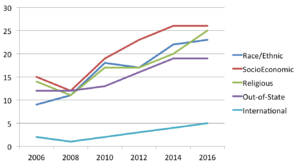Although every weekend before the start of a fall term seems to bring a surge of energy to campus, this fall feels just a little bit different. I’m not sure I can put my finger on it just yet, but what usually seems like a low hum of electrical current has been elevated to a palpable buzz throughout the quad. It’s almost as if we’ve crossed some sort of invisible threshold where a confluence of undercurrents have achieved a synergy that is about to burst into a kaleidoscopic firework display of sparkle and color.
Over the last 10 years, the Augustana student body has grown more diverse on a variety of dimensions. The graph below shows the growing proportions of students from five different demographic groups since 2006. The race/ethnic line (blue) represents the proportion of non-white students. The socioeconomic line (red) represents the proportion of Pell Grant recipients. The religious line (green) represents the proportion of students who identify with a belief system that is not Protestant or Catholic. The out-of-state line (purple) represents the proportion of students who are from states other than Illinois. And the international line (light blue) represents the students who are coming to Augustana from a country outside of the United States.

These demographic shifts don’t happen by chance, and we ought to recognize and applaud the policy decisions that helped to bolster these trends.
But without a concerted and sustained commitment to make the most of this blossoming tapestry of difference, we leave ourselves vulnerable to a devastating missed opportunity. It would be terribly disappointing if all of this effort to bring such a wealth of diversity to campus produced nothing more than larger groups of homogeneity sitting in separate corners of the Gerber dining hall.
Weaving our varied demographics into a single diverse tapestry will take a continual effort to create, cultivate, and sometimes even coerce meaningful interactions across difference. This will mean that all of us will have to recognize our very human tendency to find comfort in familiarity. Although I’m not suggesting that we shun the familiar, we must humbly recognize our frailty and make the choice to open ourselves to new relationships, new ideas, and new experiences.
I know that helping young people navigate such a complex challenge is not simple, and it certainly doesn’t happen overnight. And, to be clear, I’m definitely not suggesting that we should shove our students into situations that are beyond their capability or maturity. But if we are to weave the diverse tapestry that we imagine, then we will need to put our collective shoulder to the grindstone and push, steadily, kindly, and purposefully; especially when the conversations turn difficult and and our vulnerabilities and insecurities feel exposed.
We have gathered the resources together on this campus to make difference one of our most powerful assets. Now let’s get to work.
Make it a good day,
Mark
